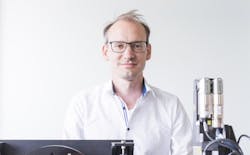LiDAR (light detection and ranging) is remote sensing measurement technology that emits and recaptures laser pulses over a broad field of view, with high frequency and precision, ultimately allowing for objects in a particular space to be reliably detected and localized. In today’s world, machines are becoming more and more intelligent; and processes, more automated. To shape this ever-changing future, a holistic approach toward environmental perception is required, whereby LiDAR proves to be a crucial piece of technology to extract data sources for these machines.
With software-definable “smart lidar,” sensors are able to be adapted into an extensive array of use cases - all from a simple mouse click. Parameters such as the field of a particular view, the resolution or specific points of interest can be adjusted by software and thereby converted into variating mounting points. Bickfeld's smart sensing solutions, which include 3D LiDAR hardware and software, empower applications across a wide range of industries.
Throughout travel settings, such as airports, the technology has been integrated into Frankfurt Airport and is currently being installed within Baltimore Airports’ retailing areas to gain further insight into customer’s movement patterns, ultimately optimizing the overall shopping experience. In Frankfurt, the technology is used to accurately capture people’s surrounding environments alongside seamless people counting capabilities to optimize the people flow processes at multiple security checkpoints throughout the airport.
At a time when countries across the globe are still on the path to recovery from the COVID-19 pandemic - alongside its detrimental impact on social interactions altogether - people counting and crowd management technology has never been so important to public health. Many retailing spaces and venues are yet to lift these guidelines within many cities, forcing customers to limit their contact with others to ensure safety for all during these interactions.
This is where LiDAR comes in with very accurate real-time data are provided: People and objects (passengers, trolleys, dogs) can be reliably detected, counted, classified and their paths traced. In airports, this proves to be a hugely beneficial point of difference compared to other forms of tracking. Due to its extensive range, the data can be collected from a safe distance without endangering the safety of the workers. The ability to undertake multiple-point scanning makes LiDAR perfect among the everyday hustle and bustle of airport settings. What’s more, LiDAR can also operate in the dark, meaning it can provide continuous and real-time measurement even during the night, allowing for 24/7 monitoring in all areas of the airport.
Anonymity plays a major part here, too. LiDAR is capable of preserving people’s privacy at all times - a clear advantage over other sensor technologies, such as cameras, which capture people’s facial features. Blickfeld's 3D hardware and software is suited for such public environments, as its versatility ensures a new dimension of precision and privacy, ensuring absolute anonymity. This is particularly important when trying to calculate the flow of a crowd any given time throughout the airport, or the number of people boarding a specific plane for instance. It is once the data has been collected by LiDAR sensors in real time, that workers and management teams are able to manage real-life operations on the ground.
Once the data, forecasts and reports are collected, the information can be accessed, digested and utilized for ongoing and future management of public safety, as well as for general everyday crowd management. In Frankfurt Airport, Blickfeld sensors are used daily to accurately capture people passing through the airport’s terminals. By counting and recording the direction of travelers, it can analyze the occupancy and utilization of an area. The sensors can also be used to make predictions regarding expected queue lengths at checkpoints 10 minutes ahead of these starting to build. Blickfeld's Percept software has been designed to compute actionable information out of sensor data, which can be accessed through a web-based user interface (WebGUI). This data can later be translated into the number of people who check in carry-on cases, ultimately allowing for a more controlled and seamless security process.
LiDAR’s capabilities can also determine the length of a customer's stay, providing staff with an approximate timing of expected arrivals/departures. Or on a more safety-related note, intrusions of unauthorized groups of people into sensitive areas within these spaces can also be reliably detected, as Blickfeld’s technology makes perimeter intrusion detection systems (PIDS) for high-security areas much more efficient. Of course, understanding where big flows of people are expected to be within these public spaces seems straightforward - it is accessing the real-time data which proves to be challenging. Ultimately, Blickfeld’s technology thinks for and with people, accurately digitizing processes and capturing chosen environments.
Another compelling argument in favor of LiDAR is that of the reduced cost for manual labor. Thanks to the large field of view, only a small number of devices is needed to cover a large area. Effectively, the LiDAR sensors are easy to install and, whereas comparable sensor technology is often installed so that it looks straight down, Blickfeld’s LiDAR sensors offer flexible sensor mounting options to observe and track areas at almost any angle needed. With this, both the setup and configuration of the technology proves to be straightforward too, whereby the GUI-based Percept software suite can be used for the definition of various types of counting zones. Once this is expected to be used for a new purpose, the very same sensor is adaptable for these other uses through the click of the mouse - there is no need to change the hardware at all.
Furthermore, the 3D capabilities of LiDAR sensors enable data to be processed smoothly as the technology directly captures the environment in tangible ways, however it may be needed. This ensures that the data collected is highly accurate with a low susceptibility for error, ultimately ensuring less false alarms to prevent alarm fatigue amongst airport personnel and increase confidence in the systems altogether.
Dr. Florian Petit, Blickfeld's chief experience officer, is a co-founder of Blickfeld.





